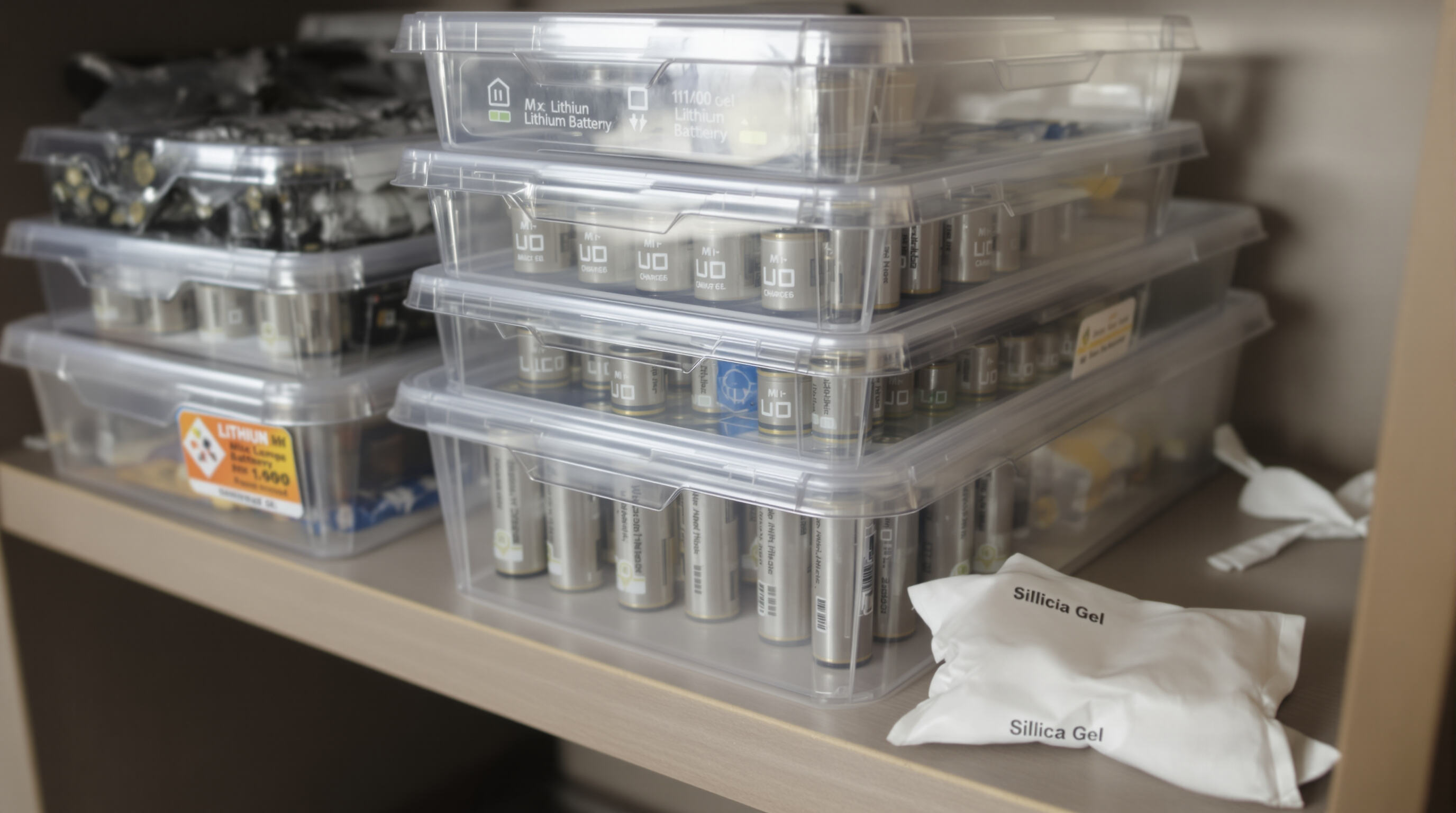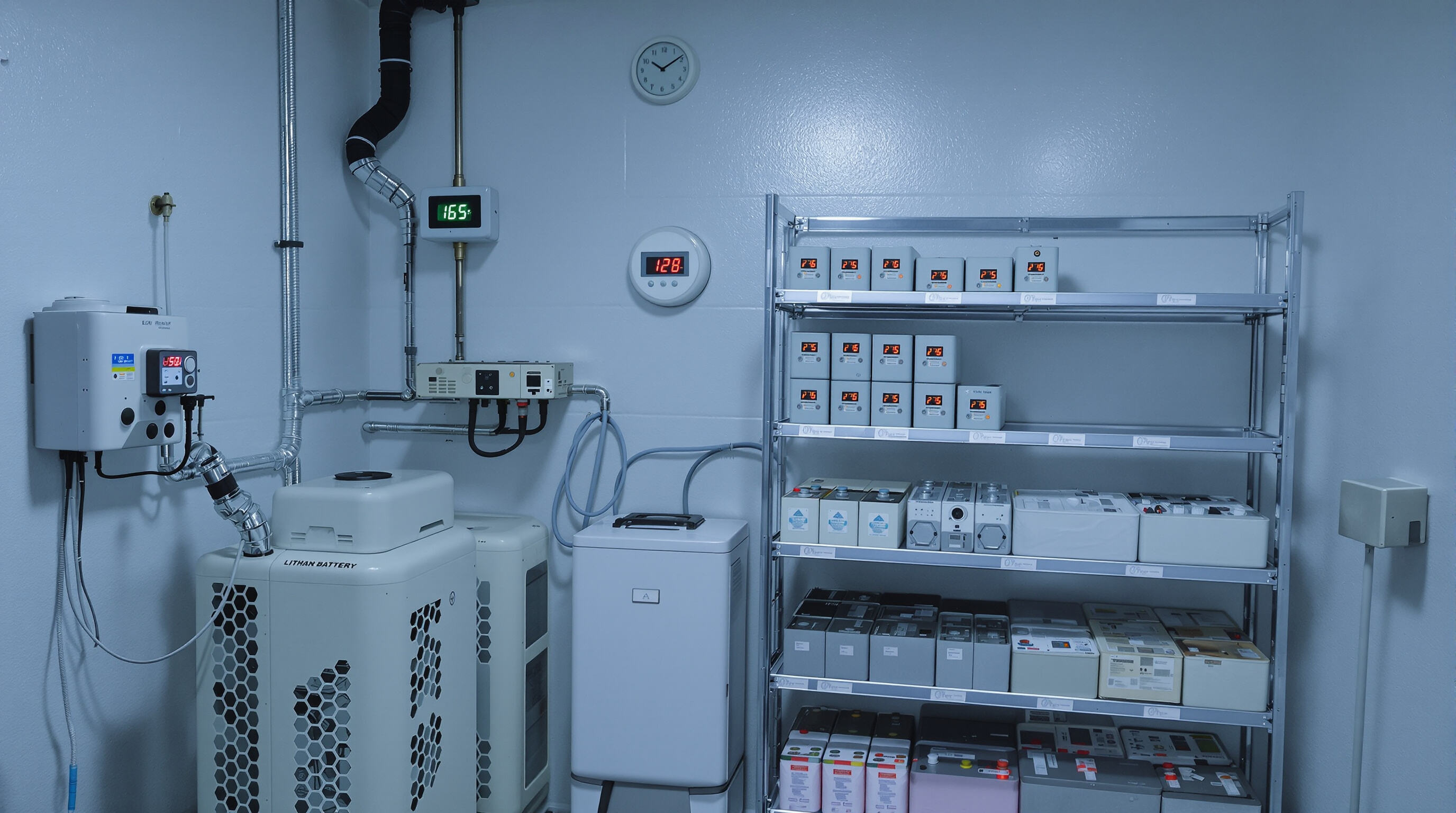Lithium based rechargeable batteries carry serious fire risks because of something called thermal runaway. This is basically when the battery starts heating itself up uncontrollably and might even explode. The problem usually happens after the battery gets damaged physically, gets overcharged, or sits in temperatures hotter than 60 degrees Celsius. These conditions break down the internal parts that keep things separated inside the battery, which then causes chemical reactions releasing those flammable electrolyte materials. Just one cell getting pierced can set off nearby cells almost instantly. To manage all this danger, manufacturers need good voltage control systems and proper discharge procedures before storage or transport. Many companies now include special safety features built right into their battery designs to prevent such incidents from occurring.
The stability of batteries is really affected by both temperature and humidity levels. Research shows that when cells are stored above 25 degrees Celsius, they tend to degrade around three times quicker compared to ones kept between 15 and 20 degrees. Electrochemical testing backs this up too. When the air gets too damp, over 60% humidity actually starts to eat away at battery terminals and encourages those dangerous dendrites to grow inside the cell. This makes internal short circuits much more likely. For proper storage, it's best to keep batteries in places where the temperature stays fairly constant. Avoid putting them in attics or garages where temperatures can swing by more than 10 degrees throughout the day. Also important is keeping moisture levels down below 50%. Silica gel packs work well for absorbing excess humidity and protecting against damage from damp conditions.
When batteries get too hot for too long, it's basically thermal abuse and one of the main reasons they fail early on. Anyone who leaves their battery packs near heating vents, close to running motors, or out in the sun will notice problems pretty quickly. The cathodes start breaking down over time, which means the battery holds less charge each year somewhere between 15% and maybe even 30%. If these batteries keep getting hit with temps over 40 degrees Celsius, something bad happens inside. The electrolyte starts turning into gas, which makes the casing swell up and creates real safety issues when trying to charge them later. From what we've seen in infrared testing, keeping storage areas under 30 degrees is crucial. Most folks fix this problem by making sure there's enough space around batteries for air to circulate and sometimes adding some kind of heat shield material between the battery and whatever might be generating warmth nearby.

Lithium rechargeable batteries maintain peak performance when stored at 40–50% charge. This “Goldilocks zone” minimizes stress on the cathode and anode, preventing lithium plating—a side reaction that degrades electrodes. A 2023 analysis of 12 major lithium-ion battery producers found that 92% recommend partial charging for storage, underscoring broad industry consensus.
Keeping batteries at full charge actually speeds up the breakdown of their internal chemicals, whereas letting them drain completely can lead to dangerous copper buildup inside the battery cells. According to the latest edition of the International Fire Code from 2024, storing batteries at no more than 30% charge reduces the chance of overheating incidents by around 37% when compared to storing them fully charged. Most regular folks find that keeping their batteries between 40 and 50% charged works best in practice. This gives enough room for the natural 5% monthly loss in charge without running the risk of completely draining the battery, which is what really damages them over time.
Even under ideal conditions, lithium batteries lose 2–4% capacity annually due to solid-electrolyte interphase (SEI) growth. For storage exceeding six months, recharge to 50% every 3–6 months to prevent deep discharge. While industrial battery management systems use adaptive algorithms based on temperature, manual monitoring is sufficient for consumer applications.
Key Consideration:
| Storage Duration | Recommended Action |
|---|---|
| <3 months | Store at 40-50% |
| 3-12 months | Recharge quarterly |
| >12 months | Use voltage alarms |

Lithium-ion batteries perform best when stored between 15°C and 25°C (59°F–77°F). Exposure below 0°C (32°F) reduces ionic conductivity, while temperatures above 45°C (113°F) increase the risk of thermal runaway due to separator meltdowns. Research shows cells stored at 35°C lose 30% more capacity annually than those kept at 20°C.
| Condition | Ideal Range | Risk Threshold |
|---|---|---|
| Temperature | 15°C–25°C (59°F–77°F) | <0°C or >45°C (32°F–113°F) |
| Relative Humidity | 45–55% | >90% |
Never keep batteries close to radiators, under direct sun exposure, or locked inside closed cars during hot weather. Temperature control matters a lot for battery health. When temperatures jump around by more than 10 degrees Celsius (about 18 Fahrenheit) each day, the electrodes inside actually expand and contract, creating real mechanical stress over time. For smaller collections at home or office, insulated plastic boxes work best when placed somewhere with stable room temperatures. Big operations need proper HVAC systems that can hold temperatures within a tight ±2 degree range. This helps stop certain areas from aging faster than others, which would shorten overall lifespan significantly.
When humidity levels climb above 70%, terminals start corroding and there's a risk of hydrofluoric acid forming inside battery enclosures, which cuts down on battery life by around 40% in hot, humid climates. On the flip side, when humidity drops below 30%, static electricity becomes a bigger problem that can damage sensitive components. Good airflow is essential here, aiming for between six and twelve complete air changes every hour helps clear out those nasty volatile organic compounds coming off older battery cells. Most facilities use either silica gel packs or industrial dehumidifiers to keep things stable, particularly important for storing lithium iron phosphate batteries since they're so sensitive to moisture fluctuations. Industry experts generally recommend regular monitoring and maintenance of these environmental controls.
For daily or weekly use, store batteries at 40–50% charge in a dry, room-temperature environment (15–25°C/59–77°F). This reduces electrode stress while maintaining readiness. Use non-conductive containers, avoid stacking, and keep batteries away from metal objects. Do not leave them in devices for more than 30 days to prevent parasitic drain.
Batteries stored for six months or longer require strict environmental control:
| Factor | Ideal Condition | Monitoring Frequency |
|---|---|---|
| Charge Level | 40–50% | Every 3 months |
| Ambient Temperature | 10–20°C (50–68°F) | Monthly |
| Humidity | <50% Relative Humidity | Biweekly |
A 2023 Battery Safety Report found that batteries stored at full charge for six months lost 18–22% capacity, compared to only 2–4% when stored at 50%. Climate-controlled storage is strongly advised.
Lithium-ion batteries self-discharge at 1.5–2% per month. To prevent deep discharge, recharge to 50% every 6–9 months, but never exceed 85% during maintenance charging. Allowing charge to drop below 5% accelerates sulfation, a degradation process costing U.S. businesses $740 million annually in premature replacements (Ponemon 2023).
Most major manufacturers along with safety organizations such as UL Solutions and the National Fire Protection Association have pretty much settled on some basic storage guidelines. Temperatures need to stay somewhere around 10 to 25 degrees Celsius, which translates to about 50 to 77 Fahrenheit, while keeping humidity levels between 50 and 60 percent seems ideal. According to NFPA standard 855, batteries must be kept away from anything that could catch fire and there needs to be ongoing checks on temperature conditions. Some important things to remember when handling these items include always keeping them upright with their protective covers in place, and definitely not letting them pile up loosely together. For bigger operations, installing thermal imaging equipment makes sense alongside passive fire suppression systems. These measures help prevent those dangerous situations where batteries start overheating uncontrollably.
According to a study by Battery University in 2023 looking at around 2,000 returned power tool batteries, those stored improperly lost about two thirds of their capacity within just 18 months. The ones kept under good conditions only dropped below 20%. When batteries degrade this badly, they tend to show problems with voltage drops and something called lithium plating on the electrodes. Researchers found that many smart devices fail early because people often leave them charging all the time when temperatures get above 30 degrees Celsius. Looking deeper into why this happens, scientists point to faster formation of what's known as the SEI layer plus chemical breakdown of the electrolyte solution inside the battery cells when they remain fully charged for long periods.
Most experts agree that keeping batteries partially charged helps cut down on unwanted chemical reactions inside them. According to studies from the Electrochemical Society, batteries left at full charge (100% SOC) see their internal resistance go up about 15% each month. That's way worse than what happens when they're kept around 60% full, where resistance only climbs about 2.2%. Major manufacturers including Dell and Tesla recommend maintaining battery levels between 40 and 60 percent for better chemical balance over time. When storing batteries for extended periods, it makes sense to rotate through inventory every three months. Recharging all units to roughly 50% capacity every 90 days helps combat natural discharge issues and stops serious problems like copper dissolving permanently once levels drop below 20% SOC.
Lithium rechargeable batteries are primarily at risk due to thermal runaway, fire hazards, and degradation from improper storage conditions, including extreme temperatures and humidity levels.
To extend battery life, store lithium batteries at a partial charge (40-50%) in a climate-controlled environment with stable temperatures between 15-25°C and humidity levels between 45-55%.
For long-term storage, maintain batteries at 40-50% charge, monitor environmental conditions regularly, and recharge them to about 50% every 3-6 months to prevent deep discharge.
Partial charging reduces stress on battery components, minimizes degradation, and helps maintain chemical balance within the cells, which prevents unwanted chemical reactions and prolongs battery life.